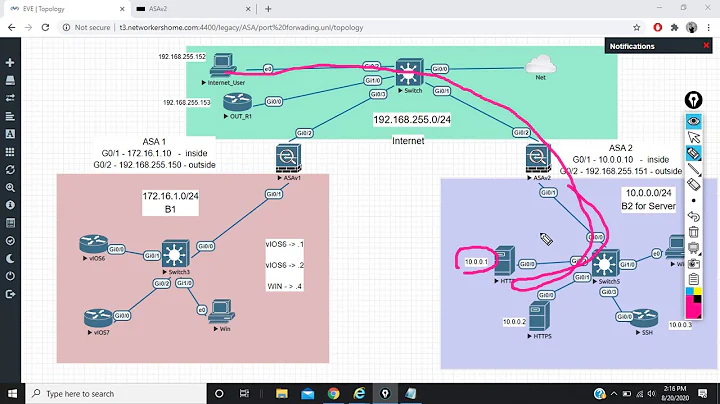Cisco ASA 8.4 port forwarding
As of version 8.3, access lists applied with an access-group statement always use the real IP address, even if the incoming packet is directed at a NAT'd IP; see the ASA Version 8.3 Migration Guide for details.
Your access list should instead look like this:
access-list VM_IN extended permit tcp any host 172.16.1.125 eq 777
Or, even better, use the object so you only have to update it in one place in the future:
access-list VM_IN extended permit tcp any object VM eq 777
EDIT (reflecting clarification from Astron):
To do inbound port forwarding to an internal host 192.168.1.125 on an interface that has a dynamically-assigned address (e.g. DHCP):
object network VM
host 192.168.1.125
!
object network VM
nat (inside,outside) static interface service tcp 777 777
!
access-list VM_IN extended permit tcp any object VM eq 777
!
access-group VM_IN in interface outside
The key is the static interface part in the nat statement. It will replace interface with whatever the IP of the outside interface happens to be at the time a packet arrives for translation.
Related videos on Youtube
Astron
Updated on September 18, 2022Comments
-
Astron over 1 year
I am having trouble port-forwarding on an Cisco ASA from a host on the internet to a host on the internal network. The outside interface of the ASA is assigned via DHCP. Is there something else that has to be done in order to make this work correctly?
update to problem
(outside) to (outside) source dynamic VPN_NETWORK interfaceper:
https://www.cisco.com/en/US/docs/security/asa/asa84/configuration/guide/nat_rules.html
(outside) to (outside) after-auto source dynamic VPN_NETWORK interfacepacket-tracer:
# packet-tracer input outside tcp 74.x.x.x 1025 71.x.x.x 555 Phase: 1 Type: ROUTE-LOOKUP Subtype: input Result: ALLOW Config: Additional Information: in 71.x.x.x 255.255.255.255 identity Phase: 2 Type: ACCESS-LIST Subtype: Result: DROP Config: Implicit Rule Additional Information: Result: input-interface: outside input-status: up input-line-status: up output-interface: NP Identity Ifc output-status: up output-line-status: up Action: drop Drop-reason: (acl-drop) Flow is denied by configured rulerunning-config
ASA Version 8.4(2) ! hostname asa enable password ***** encrypted passwd ***** encrypted names ! interface Ethernet0/0 switchport access vlan 2 ! interface Ethernet0/1 ! interface Ethernet0/2 ! interface Ethernet0/3 ! interface Ethernet0/4 ! interface Ethernet0/5 ! interface Ethernet0/6 ! interface Ethernet0/7 ! interface Vlan1 nameif inside security-level 100 ip address 172.16.1.1 255.255.255.0 ! interface Vlan2 nameif outside security-level 0 ip address dhcp setroute ! boot system disk0:/asa842-k8.bin ftp mode passive same-security-traffic permit intra-interface object network obj_any subnet 0.0.0.0 0.0.0.0 object network VPN_NETWORK subnet 192.168.1.0 255.255.255.192 object network VM host 172.16.1.100 access-list dynamic-filter_acl extended permit ip any any access-list VM-IN extended permit tcp any host 172.16.1.100 eq 555 pager lines 24 logging enable logging asdm informational mtu inside 1500 mtu outside 1500 ip local pool VPN-DHCP-POOL 192.168.1.10-192.168.1.50 icmp unreachable rate-limit 1 burst-size 1 asdm image disk0:/asdm-645-206.bin no asdm history enable arp timeout 14400 nat (inside,outside) source static any any destination static VPN_NETWORK VPN_NETWORK no-proxy-arp route-lookup nat (outside,outside) source dynamic VPN_NETWORK interface ! object network obj_any nat (inside,outside) dynamic interface object network VM nat (inside,outside) static interface service tcp 555 555 access-group VM-IN in interface outside timeout xlate 3:00:00 timeout conn 1:00:00 half-closed 0:10:00 udp 0:02:00 icmp 0:00:02 timeout sunrpc 0:10:00 h323 0:05:00 h225 1:00:00 mgcp 0:05:00 mgcp-pat 0:05:00 timeout sip 0:30:00 sip_media 0:02:00 sip-invite 0:03:00 sip-disconnect 0:02:00 timeout sip-provisional-media 0:02:00 uauth 0:05:00 absolute timeout tcp-proxy-reassembly 0:01:00 timeout floating-conn 0:00:00 dynamic-access-policy-record DfltAccessPolicy user-identity default-domain LOCAL aaa authentication http console LOCAL aaa authentication ssh console LOCAL http server enable http 172.16.1.0 255.255.255.0 inside no snmp-server location no snmp-server contact snmp-server enable traps snmp authentication linkup linkdown coldstart crypto ipsec ikev1 transform-set ESP-AES-256-SHA esp-aes-256 esp-sha-hmac crypto ipsec ikev1 transform-set ESP-AES-128-SHA esp-aes esp-sha-hmac crypto ipsec ikev1 transform-set ESP-AES-192-SHA esp-aes-192 esp-sha-hmac crypto dynamic-map SYSTEM_DEFAULT_CRYPTO_MAP 65535 set pfs group1 crypto dynamic-map SYSTEM_DEFAULT_CRYPTO_MAP 65535 set ikev1 transform-set ESP-AES-256-SHA crypto map outside_map 65535 ipsec-isakmp dynamic SYSTEM_DEFAULT_CRYPTO_MAP crypto map outside_map interface outside crypto map inside_map 65535 ipsec-isakmp dynamic SYSTEM_DEFAULT_CRYPTO_MAP crypto map inside_map interface inside crypto ikev1 enable inside crypto ikev1 enable outside crypto ikev1 policy 10 authentication crack encryption aes-256 hash sha group 2 lifetime 86400 crypto ikev1 policy 20 authentication rsa-sig encryption aes-256 hash sha group 2 lifetime 86400 crypto ikev1 policy 30 authentication pre-share encryption aes-256 hash sha group 2 lifetime 86400 telnet timeout 5 ssh 172.16.1.0 255.255.255.0 inside ssh timeout 5 ssh version 2 console timeout 0 dhcp-client client-id interface outside dhcpd auto_config outside ! dhcpd address 172.16.1.100-172.16.1.200 inside dhcpd dns 8.8.8.8 8.8.4.4 interface inside dhcpd option 3 ip 172.16.1.1 interface inside dhcpd enable inside ! threat-detection basic-threat threat-detection statistics access-list no threat-detection statistics tcp-intercept dynamic-filter enable interface outside classify-list dynamic-filter_acl dynamic-filter drop blacklist interface outside ssl encryption des-sha1 webvpn group-policy EdgeAccess internal group-policy EdgeAccess attributes dns-server value 8.8.8.8 8.8.4.4 vpn-tunnel-protocol ikev1 username user password ***** encrypted tunnel-group EdgeAccess type remote-access tunnel-group EdgeAccess general-attributes address-pool VPN-DHCP-POOL default-group-policy EdgeAccess tunnel-group EdgeAccess ipsec-attributes ikev1 pre-shared-key ***** ! class-map inspection_default match default-inspection-traffic ! ! policy-map type inspect dns preset_dns_map parameters message-length maximum 512 policy-map global_policy class inspection_default inspect dns preset_dns_map inspect ftp inspect h323 h225 inspect h323 ras inspect rsh inspect rtsp inspect esmtp inspect sqlnet inspect skinny inspect sunrpc inspect xdmcp inspect sip inspect netbios inspect tftp inspect ip-options ! service-policy global_policy global privilege show level 0 mode configure command filter privilege cmd level 0 mode configure command filter privilege cmd level 0 mode config-group-webvpn command filter privilege cmd level 0 mode config-username-webvpn command filter prompt hostname context no call-home reporting anonymous : end-
James Sneeringer over 12 yearsSorry, my answer made more sense before your edit. Your configuration now has you NAT'ing an IP to itself. This made sense on pre-8.3 systems as a static NAT exemption, but not on 8.4. Can you explain what you're trying to do?
-
Astron over 12 yearsYes, if a request for TCP port 777 arrives at the outside interface, it is forwarded to host .125 on the internal network.
-
James Sneeringer over 12 yearsThe
VMobject should be the internal IP, and the IP shown in thenatstatement should be the external IP. In the current form form of your question, both are the same. If we talk about your unedited question, with 172.16.1.125 as the real/inside and 192.168.1.125 as the NAT/outside, all you need to do is change youraccess-listto refer to 172.16.1.125 instead of 192.168.1.125. -
Astron over 12 yearsThat was just a mistake, is there not a way to port forward without specifying an external IP address? The
outsideinterface is DHCP and it would be tedious to change the rules every time the external address changes. Dis-regard the class-B network references. -
James Sneeringer over 12 yearsMy answer has been updated accordingly.
-
James Sneeringer over 12 yearsOutput from
packet-tracerindicates asymmetric NAT, which means your packet is matching different NAT statements in the inbound and outbound directions. What does the rest of your NAT configuration look like? Anything else that matches 192.168.1.125? -
James Sneeringer over 12 yearsIn your latest update, the drop is due to an implicit rule, which means some default condition not explicitly stated in your configuration caused it. This may be because the ASA is already using port 22 on its outside interface, and you lack an
sshstatement permitting the connection. If this is the case, you will need to modify the outside mapped port to something the ASA doesn't use. -
Astron over 12 yearsThe device does use
SSHthough on the inside interface, regardless I changed everything to555and still have the same result. Any other ideas? -
James Sneeringer over 12 yearsI duplicated the config I posted below on an otherwise bare 5520 running 8.4(2)8, using port 22 for everything, and it works fine for me (so my previous comment about port 22 and
sshis invalid). Can you post your complete (sanitized) config somewhere for us to see? And please verify the exact version you're using, since it's possible (though unlikely) that you're tripping over a bug. Also, when you runpacket-tracer, make sure you specify the NAT/interface IP as the destination; using the real inside IP seem to be what triggers the drop due torpf-check. -
Astron over 12 years@JamesSneeringer I changed to port 555 in order to avoid conflict with the ASA service running on the ASA.
8.4(2)is the current version running on the device. Packet-trace has been updated as the internal interface was tripping therpf-check. -
Astron over 12 years@JamesSneeringer Update to 8.4(3) does not seem to of made a difference.
-
-
Astron over 12 yearsHow is this any different than what I have in the original question?
-
James Sneeringer over 12 yearsEdited so the IP reflects your original question. I copied the wrong one into my answer.
-
Astron over 12 yearsMade the change and provided output from
packet-tracer. Would the VPN config have anything to do with the denial? -
 gravyface over 12 yearsshudder no idea why Cisco went this route with their syntax.
gravyface over 12 yearsshudder no idea why Cisco went this route with their syntax. -
Weaver over 12 years@gravyface Because once you cross the 100+ (in some configs 1000+) configuration objectives (be they NAT, ACL/ACE's, tunnels, etc) on an ASA using traditional ASA/PIX 7.x (through ASA 8.2) the weaknesses become apparent from a management standpoint. The 8.3+ forced objects, object-based NAT, real-ip in interface ACL's, and a lot of other 8.3+ features -- in the hands of a network engineer that plans configurations -- are very powerful. IMHO of course. :)
-
 gravyface over 12 yearsHumble indeed. :/
gravyface over 12 yearsHumble indeed. :/ -
Astron over 12 years@JamesSneeringer Problem was the hairpin NAT statement I have for the VPN. This was causing an issue with the correct port-forwarding rules you provided.
-
James Sneeringer over 12 yearsNice catch! We don't have this kind of setup, so I was unfamiliar with
after-auto.




